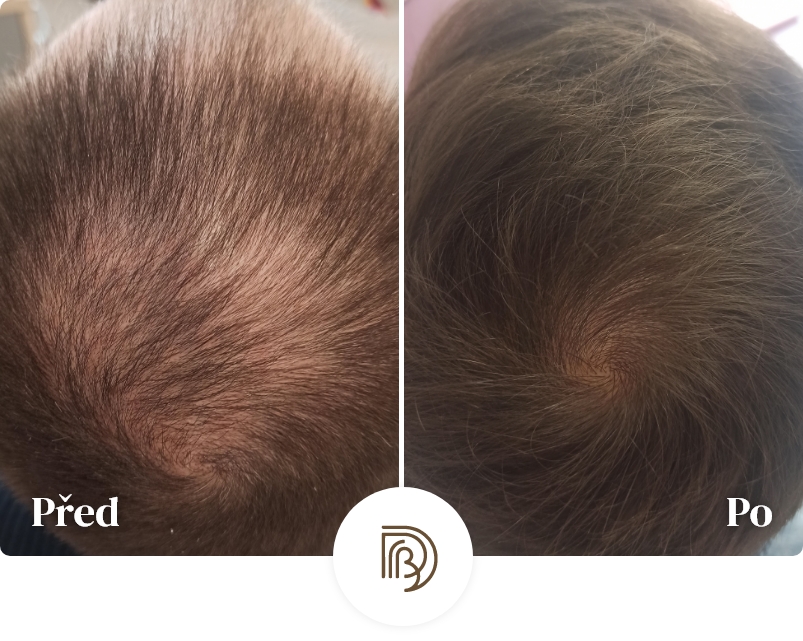
Article content
- Hair Plasmatherapy (PRP)
- Article content
- PRP for hair loss
- Why platelets, anyway?
- Truth and myths about hair loss treatment with plasmatherapy
- Differences in the application of the PRP
- How plasmatherapy treatment works step by step
- Clinical studies on the effectiveness of hair plasmatherapy
- To whom I recommend hair plasmatherapy and to whom not
- Make an appointment
- Similar posts
Plasmatherapy or PRP (Platelet Rich Plasma) has become very popular in recent years. The concept of PRP is quite simple: it involves taking a small amount of the patient’s blood, centrifuging it to separate the plasma (the liquid part of the blood) and the platelets, and then injecting the plasma with concentrated platelets into a designated area of the skin.
Although this method began to be used in orthopaedics to treat tendons and joints, today it is mostly used in aesthetic dermatology to rejuvenate the skin of virtually any part of the body. Hands, face, décolletage, neck. And I use hair plasmatherapy, which I will tell you more about, as a supporting method in the treatment of some types of hair loss. How does it actually work? What is my experience with plasmatherapy? And how much does PRP actually cost? I write about all this in this article.
PRP for hair loss
When it comes to hair loss, plasmatherapy works by regenerates and nourishes the scalp and stimulates inactive hair follicles into an active growth phase. While this will not create new hair follicles, it will strengthen the existing ones. And by activating the inactive follicles, new hair growth occurs, leading to thicker and fuller hair.
Facts
- Plasmatherapy (PRP) is an injectable method of promoting hair growth
- It works on the principle of using plasma and platelets from the patient’s own blood
- Platelet enriched plasma nourishes and regenerates the scalp
- And this stimulates hair growth
- Plasmatherapy can only be administered by a doctor!
Why platelets, anyway?
Platelets (thrombocytes) contain many different types of growth factors that you’ve probably never heard of. These include platelet-derived growth factor, transforming growth factor, vascular endothelial growth factor and epidermal growth factor. These growth factors secreted by platelets help skin regeneration by:
- Stimulate blood vessel formation
- Promote cell division and development
- Promote collagen production
- Support stem cell activity
- Prevent degeneration of healthy tissues
- They release proteins that allow new cells to fuse and rebuild tissue
The injected platelet-rich plasma contains a greater amount of growth factors than our blood. As a result, PRP improves and accelerates the growth of new cells.
Truth and myths about hair loss treatment with plasmatherapy
On the internet you can read a lot of half-truths and misleading information about the use of PRP in the treatment of hair loss or various types of alopecia.
Hair plasmatherapy as the only and most effective method
First of all, it should be pointed out that plasma therapy is not self-sustaining. Although more and more clinical studies show the positive effect of this method in the treatment of various hair diseases, the combination of plasma therapy and oral or topical drugs is still the most effective (minoxidil, finasteride and others).
Plasmatherapy is painless
No injection of a drug into live skin is completely pain-free. Patients experience minor pain during injection or pressure during individual injections of plasma into the skin. Of course, everyone has a different pain threshold and perceives pain differently. Pain during injection largely depends on the size and sharpness of the needle. As there are more punctures in the skin during this procedure, the needle naturally dulls. Therefore, I use very thin needles for plasmatherapy and change them several times during the application.
Differences in the application of the PRP
Of course, there are also differences in the application, better said in the quality of application, so ideally you want to go to an expert in the treatment of hair loss. Of course, the amount of plasma applied, where the plasma is applied on the scalp, the spacing between injections, the depth of the injection and many other small details play an important role. And remember that plasmatherapy can only be applied by a doctor, never by an aesthetician, nurse or anyone else.
No two plasmatherapies are the same
Currently , there is no established method of preparing plasma for use in the treatment of hair diseases. There are several methods of preparation, the amount of blood taken varies, the anticollagen used to prevent clotting in the tube varies, the time taken to centrifuge the blood varies and the composition of the resulting plasma varies. Pharmaceutical companies produce kits for the preparation and application of plasmatherapy at different price levels, which is why there is such a variance in application prices on the market. No two plasmatherapies are the same, so ask before you apply what you will get.
How plasmatherapy treatment works step by step
The basis of everything is a detailed medical history and a correct diagnosis. PRP for hair is not suitable for every patient and for every diagnosis. For some patients, better results can be achieved with another method of treatment, for some patients plasmatherapy cannot be performed at all. This applies to patients with platelet disorders, certain types of heart disease or some patients with high blood pressure.
Therefore, it is not possible to make an appointment for hair plasmatherapy directly, you must always come to my office for an initial examination. We will discuss your medical history together, diagnose your problem and then discuss whether or not plasma therapy is a suitable solution for you.
- Before treatment
Your water intake is important. Ideally, increase fluid intake to at least 2-3 litres (not alcohol) for 24 hours before plasmatherapy. Ideally avoid drinking coffee, green tea, energy drinks and smoking before blood collection.
At least 3 days before the procedure, stop using non-steroidal anti-inflammatory medications such as Ibuprofen, Diclofenac, Valetol and others.
- The treatment itself
Blood collection: a small amount of blood, usually 15 millilitres, is drawn from the patient’s arm. This process is similar to a normal blood draw.
Centrifugation: the blood sample is put into a centrifuge where it is spun at high speed. This centrifugation separates the blood into layers, with the PRP layer containing a high concentration of platelets and growth factors.
Application: Once the PRP is prepared, it is injected into the targeted areas of the scalp using a very fine mesotherapy needle. The application is only minimally painful.
- After treatment
In 20-30 minutes it’s done and you can go home or to work. The procedure is non-invasive and no recovery is required. Ideally, you should not exercise for a day after the application (the scalp is more sensitive and could be painful) and it is also a good idea to avoid excessive sweating (sauna, solarium, intense sports) until the needle puncture wounds are completely healed, i.e. at least 3 days. Do not wash your hair for at least a day after the application. It is advisable to protect yourself from direct sunlight for 3 days.
- Variants to treat hair loss with plasmatherapy
My other favourite option for the supportive treatment of hair loss is mesotherapy, where the patient’s blood is not treated, but a pre-prepared solution rich in vitamins, minerals, amino acids, stem cells, peptides and enzymes is injected into the scalp. In short, everything the hair needs to support its growth. Mesotherapy can be likened to dietary supplements, but in an injectable form that is directed directly to the areas where they are most beneficial. You can read more about mesotherapy in this article.
Clinical studies on the effectiveness of hair plasmatherapy
More and more research teams are beginning to focus on hair diseases and their treatment. As a result, more and more information is coming out about how to better diagnose the diseases, understand how they are caused and what causes them, and how to treat them more successfully.
- PRP is more effective in the treatment of androgenetic alopecia than conventional topical treatment with 5% minoxidil and can be used as an adjunctive therapy (Borowiecka et al., 2022).
- Combination treatment with PRP and minoxidil leads to better clinical outcomes in men with androgenetic alopecia than monotherapy with these methods (Elena & Irina, 2022).
- The review highlighted the efficacy of regenerative cell therapies, including PRP, in the most advanced types of alopecia. The article highlighted the role of stem cells in regenerative therapy for hair restoration (which plasmatherapy contains) (Anudeep et al., 2022).
To whom I recommend hair plasmatherapy and to whom not
Plasmatherapy is primarily suitable for the treatment of Androgenetic Alopecia and Telogen Effluvium, but can also be used for other types of disease. It is ideal to undergo 3 treatments with monthly intervals between applications. For some, the higher cost may be a barrier, so I do not force my patients to use this method.
I also see patients who, for some reasons, refuse treatment with standard medications such as minoxidil, finasteride or dutasteride. Whether it is because of contraindications to these drugs due to their other health problems or fear of the side effects of the medications. But lately, there have been more patients who refuse to take medications (whether oral or topical) altogether and are seeking alternative routes. Since PRP is essentially an extract of the patient’s own blood, I recommend this option to them. In my experience with plasmatherapy for hair, this form of treatment is very safe and I have never encountered any side effects.






